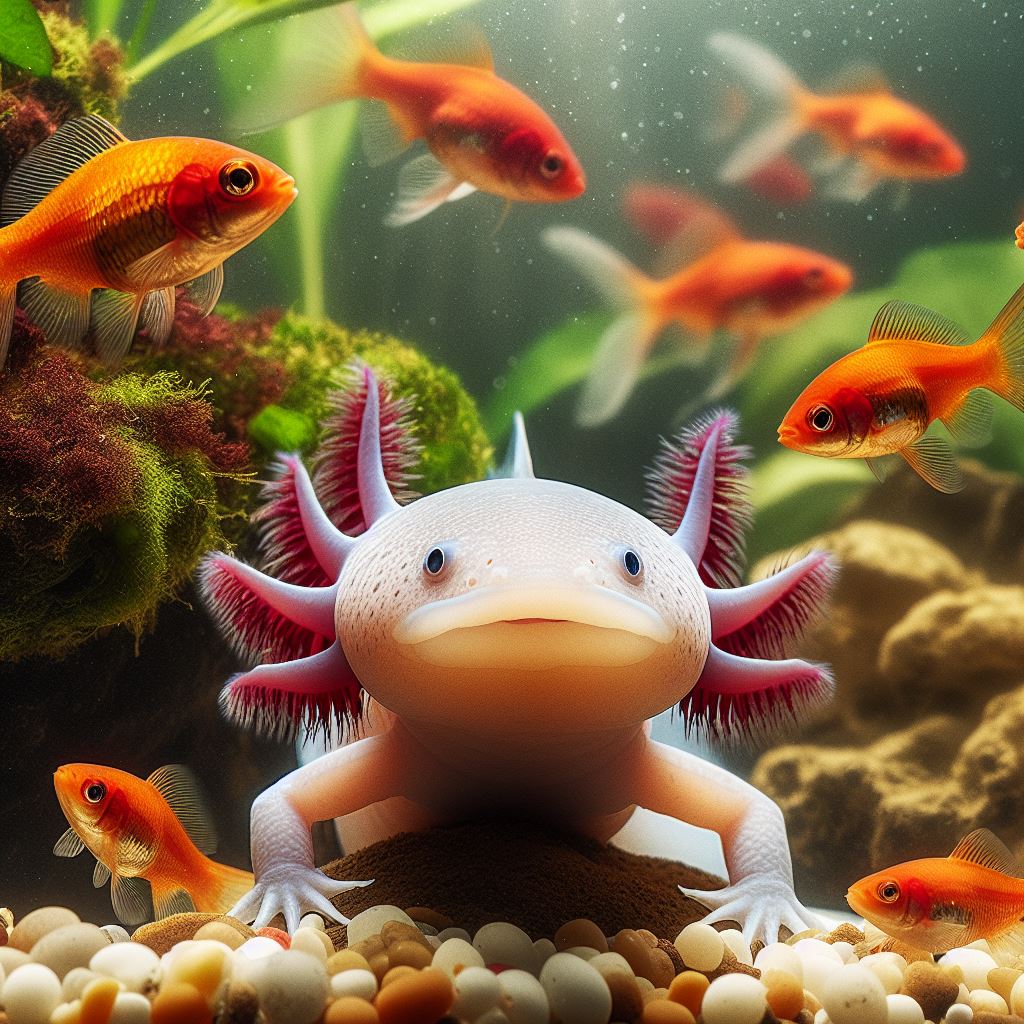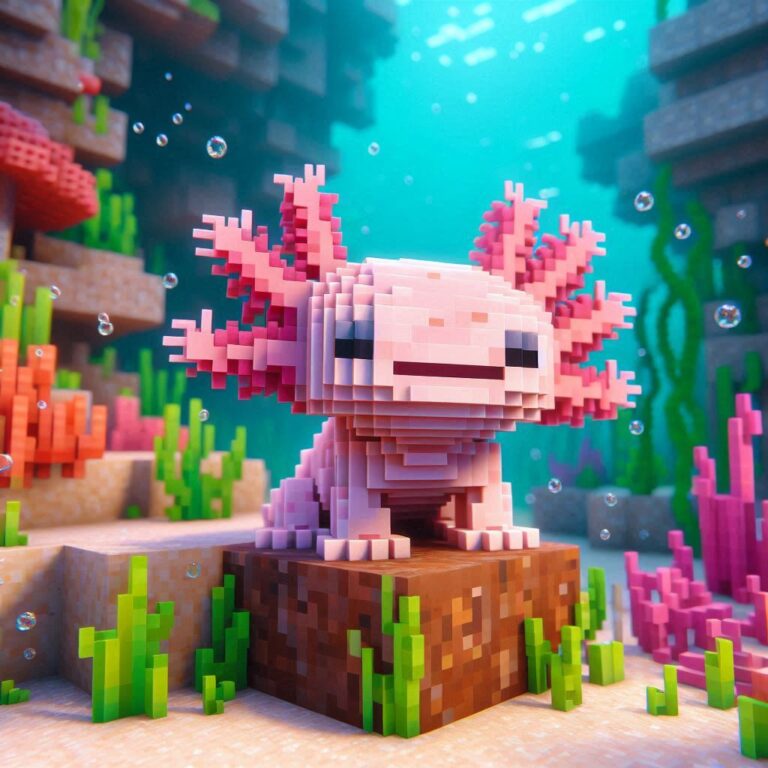
The question of whether axolotls can live with mollies often arises among aquarium enthusiasts. While both species can thrive in well-maintained aquatic environments, they have distinct habitat requirements and behaviors that make cohabitation challenging. Axolotls are amphibians native to Mexico and prefer cooler water temperatures, typically between 60-70°F (15-21°C), with plenty of hiding spots to reduce stress. On the other hand, mollies are tropical fish known for their active swimming behavior and thrive in warmer waters, usually between 75-82°F (24-28°C). Additionally, mollies may exhibit nipping behavior, which can stress axolotls and potentially lead to injury. Therefore, it’s generally recommended to house axolotls separately from mollies to ensure both species’ well-being.
Habitat Requirements: Axolotls vs. Mollies
Creating a harmonious aquatic environment that accommodates both axolotls and mollies requires a delicate balance of understanding their unique habitat requirements. Axolotls, with their origins in the cool, dark waters of Mexico’s Lake Xochimilco, have specific needs that reflect their amphibious nature. They thrive in temperatures ranging from 60 to 70°F (15-21°C), seeking refuge in densely planted areas or beneath rocks and logs. Axolotls also benefit from soft substrates like sand or smooth gravel, which prevent injuries to their delicate skin. In contrast, mollies, originating from tropical regions like Central America, prefer warmer waters between 75 and 82°F (24-28°C). They are active swimmers, necessitating open spaces for exploration and adequate filtration to maintain water quality. Providing a habitat that meets the diverse needs of both species requires careful consideration of temperature regulation, substrate composition, and the layout of plants and hiding spots.
Axolotls Habitat Needs
Axolotls, often referred to as “Mexican walking fish,” possess unique physiological traits that influence their habitat requirements. As neotenic salamanders, they retain juvenile characteristics throughout their lives, including external gills and the ability to regenerate lost limbs. To thrive, axolotls require a spacious tank with a minimum capacity of 20 gallons for a single adult, providing ample room for movement and the establishment of territories.
Tank setup should prioritize safety, with smooth surfaces and minimal decorations that could cause injury. Filtration is essential to maintain water quality, as axolotls are sensitive to toxins and ammonia buildup. Additionally, regular water changes and a stable pH level between 6.5 and 7.5 are crucial for their health and well-being. Adequate lighting, though not essential, can stimulate plant growth and provide a naturalistic environment. By replicating the cool, dark waters of their native habitat, aquarists can ensure the optimal conditions for axolotls to thrive and exhibit their fascinating behaviors.
Mollie’s Ideal Environment
Mollies, vibrant and versatile tropical fish, add a splash of color and activity to any aquarium setting. Originating from warm, freshwater habitats in Central and South America, mollies thrive in environments that replicate their natural surroundings. A spacious tank with a capacity of at least 20 gallons is recommended to accommodate their active swimming behavior and social interactions. Mollies appreciate densely planted areas and floating vegetation, providing cover and opportunities for exploration. While they are adaptable to various water conditions, stable parameters are essential for their well-being.
A pH level between 7.0 and 8.0 and water hardness of 20-30 dGH (degrees of General Hardness) are suitable for mollies. Additionally, maintaining water temperatures between 75 and 82°F (24-28°C) ensures their vitality and encourages natural behaviors like breeding and foraging. Regular water changes and efficient filtration systems help mitigate waste buildup, ensuring a clean and healthy environment for mollies to thrive. By replicating the warm, lush habitats of their native waters, aquarists can create an ideal setting for mollies to display their vibrant colors and engaging behaviors.
Mollie Behavior: How It Affects Axolotls
Understanding the behavioral dynamics between mollies and axolotls is crucial for maintaining a harmonious aquarium ecosystem. Mollies, known for their lively and sometimes aggressive nature, can significantly impact the well-being of axolotls. In a shared tank, mollies may exhibit nipping behavior, especially towards the external gills of axolotls, potentially causing stress and injury. Furthermore, their fast-paced swimming and territorial disputes can disrupt the relatively calm and sedentary lifestyle of axolotls. Therefore, careful observation and intervention may be necessary to mitigate any negative interactions between the two species. Creating separate territories within the tank or providing ample hiding spots for axolotls can help reduce stress and minimize confrontations between mollies and axolotls.
Mollie’s Social Behavior
Mollies, with their dynamic social structures and hierarchical tendencies, add a fascinating dimension to any aquarium setting. These lively fish are known for their shoaling behavior, preferring to swim in groups for safety and social interaction. In a well-established community tank, mollies often form tight-knit shoals, displaying intricate social dynamics and communication through body language and fin movements. However, their social behavior can sometimes pose challenges when housed with more passive tankmates like axolotls. Mollies may exhibit dominance behaviors, including chasing, fin nipping, and territorial disputes, which can cause stress and discomfort for axolotls. Therefore, it’s essential to monitor their interactions closely and provide ample hiding spots and territories for both species to reduce aggression and promote peaceful coexistence.
Impact on Axolotls’ Stress Levels
The social behavior of mollies can have a profound impact on the stress levels of axolotls sharing the same tank. Axolotls, with their relatively docile and solitary nature, may become stressed when exposed to the fast-paced and sometimes aggressive behaviors of mollies. Persistent harassment from mollies, such as fin nipping or chasing, can lead to heightened stress levels in axolotls, compromising their overall health and well-being. Prolonged exposure to stress can weaken the immune system of axolotls, making them more susceptible to diseases and other health issues. Therefore, it’s essential to provide a well-structured tank environment with plenty of hiding spots and territories for axolotls to retreat and minimize their exposure to stressful stimuli. Additionally, regular monitoring of their behavior and water parameters can help identify any signs of stress and take appropriate measures to address them promptly.
Dietary Differences Between Axolotls and Mollies
Understanding the dietary needs of both axolotls and mollies is essential for providing a balanced and nutritious diet in a shared aquarium setting. Axolotls, being carnivorous amphibians, primarily rely on meat-based foods to meet their nutritional requirements. Their diet in the wild consists of small fish, worms, insects, and other aquatic invertebrates. In captivity, axolotls readily accept a variety of live and frozen foods, including bloodworms, earthworms, brine shrimp, and blackworms.
It’s crucial to provide a diverse diet to ensure they receive essential nutrients and vitamins necessary for growth and overall health. On the other hand, mollies are omnivorous tropical fish with a more varied diet that includes both plant and animal matter. In addition to live and frozen foods like bloodworms and brine shrimp, mollies also graze on algae and vegetation in the aquarium. Therefore, offering a mix of plant-based and protein-rich foods is essential to meet the dietary needs of both species and promote their well-being.
Axolotls’ Feeding Habits
Axolotls, with their unique appearance and fascinating feeding behavior, captivate aquarists with their appetite for live prey. As ambush predators, axolotls rely on their keen senses to detect movement and capture unsuspecting prey with lightning-fast strikes. In the wild, they hunt primarily at night, using their sensitive lateral line to detect vibrations and locate prey in murky waters. In captivity, axolotls exhibit similar feeding behaviors, eagerly pursuing live foods like bloodworms and small fish. However, they may also accept non-living foods such as pelleted or gel-based diets, especially if introduced during their juvenile stages. It’s essential to offer appropriately sized prey items to prevent overfeeding and ensure proper digestion. Additionally, providing enrichment through interactive feeding techniques, such as using feeding tongs or hiding food within the tank, stimulates natural hunting instincts and promotes physical activity.
Suitable Foods for Mollies
Mollies, with their diverse diet and adaptable feeding habits, thrive on a combination of plant and animal-based foods in captivity. While they are omnivorous by nature, mollies show a preference for vegetable matter, including algae and aquatic plants. In the wild, they graze on algae growing on rocks and substrate, supplementing their diet with small invertebrates and insect larvae. In an aquarium setting, mollies should be offered a balanced diet consisting of high-quality flake or pellet foods formulated specifically for omnivorous fish.
These foods typically contain a mix of plant-based ingredients like spirulina and seaweed, along with protein sources such as fish meal or shrimp. Additionally, supplementing their diet with live or frozen foods like bloodworms, brine shrimp, and daphnia provides essential nutrients and encourages natural foraging behaviors. Offering a varied diet ensures that mollies receive all the essential nutrients they need to maintain vibrant colors, robust health, and overall well-being.
Potential Risks of Housing Axolotls and Mollies Together
While the idea of creating a diverse aquatic community with both axolotls and mollies may seem appealing, there are several potential risks to consider before housing these species together. One of the primary concerns is the compatibility of their habitat and behavioral needs. Axolotls, with their preference for cooler temperatures and secluded hiding spots, may struggle in an environment tailored to the active swimming and social behaviors of mollies. Additionally, mollies’ tendency to exhibit aggressive behaviors, such as nipping and fin chasing, can cause stress and injury to axolotls. Furthermore, the dietary differences between the two species pose challenges in providing a balanced diet that meets the nutritional needs of both axolotls and mollies. Overall, the potential risks of housing axolotls and mollies together include compatibility issues, disease transmission risks, and dietary challenges that may compromise the well-being of both species.
Compatibility Issues
Ensuring compatibility between axolotls and mollies in a shared aquarium setting requires careful consideration of their individual behaviors and environmental requirements. Axolotls, as solitary amphibians with a preference for cooler temperatures and hiding spots, may not thrive in the presence of mollies, known for their active swimming and shoaling behaviors. The fast-paced movements and territorial disputes of mollies can stress axolotls and disrupt their relatively calm and sedentary lifestyle. Additionally, the potential for aggression from mollies towards axolotls, including fin nipping and chasing, further exacerbates compatibility issues. Creating separate territories within the tank or providing ample hiding spots for axolotls can help mitigate aggression and reduce stress levels. However, maintaining compatibility between axolotls and mollies often requires careful monitoring and intervention to ensure the well-being of both species.
Disease Transmission Risks
Another significant concern when housing axolotls and mollies together is the risk of disease transmission between the two species. Mollies, as social and highly active fish, may carry diseases or parasites that can be harmful to axolotls, especially in environments with compromised water quality. Additionally, the stress caused by incompatible tankmates or suboptimal environmental conditions can weaken the immune system of axolotls, making them more susceptible to infections and illnesses. Therefore, it’s essential to quarantine new fish before introducing them to an established aquarium and maintain strict hygiene practices to prevent the spread of pathogens. Regular water changes, proper filtration, and monitoring water parameters are essential for minimizing disease transmission risks and ensuring the health and well-being of both axolotls and mollies in a shared tank.
Temperature and Water Quality Considerations

Maintaining optimal temperature and water quality is essential for the health and well-being of both axolotls and mollies in a shared aquarium environment. Temperature plays a crucial role in regulating metabolic processes and immune function, while water quality parameters directly impact the overall health and vitality of aquatic organisms. However, achieving a balance that meets the specific needs of both species can be challenging due to their divergent preferences. Axolotls thrive in cooler water temperatures ranging from 60 to 70°F (15-21°C), while mollies prefer warmer waters between 75 and 82°F (24-28°C).
Therefore, careful consideration must be given to temperature regulation to ensure the comfort and physiological functioning of both axolotls and mollies. Additionally, maintaining stable water quality parameters, including pH, ammonia, nitrite, and nitrate levels, is crucial for preventing stress and minimizing the risk of diseases. Regular water testing and appropriate filtration systems are essential for maintaining a healthy aquatic environment for axolotls and mollies.
Optimal Temperature Range for Axolotls
Axolotls, with their origins in the cool, dark waters of Mexico’s Lake Xochimilco, thrive in relatively low temperatures compared to tropical fish species like mollies. The optimal temperature range for axolotls typically falls between 60 and 70°F (15-21°C), although they can tolerate slightly higher temperatures for short periods. Cooler temperatures help regulate their metabolic rate, reduce stress levels, and promote overall health and longevity. However, prolonged exposure to temperatures above 72°F (22°C) can lead to heat stress and compromise the immune system of axolotls, making them more susceptible to diseases. Therefore, maintaining a consistent temperature within the recommended range is essential for ensuring the well-being of axolotls in captivity.
Water Quality Parameters for Both Species
Ensuring optimal water quality is paramount for the health and vitality of both axolotls and mollies in a shared aquarium environment. Water quality parameters, including pH, ammonia, nitrite, and nitrate levels, directly impact the physiological functioning and overall well-being of aquatic organisms. Axolotls thrive in slightly acidic to neutral water with a pH range of 6.5 to 7.5, while mollies tolerate a wider range and often prefer harder water with a higher pH. Therefore, it’s essential to monitor and maintain stable water parameters that accommodate the specific needs of both species.
Regular water testing, adequate filtration, and performing routine water changes are critical for preventing the accumulation of toxins and maintaining a healthy aquatic environment for axolotls and mollies alike. Additionally, providing sufficient aeration and oxygenation ensures optimal oxygen levels, promoting respiratory efficiency and reducing stress levels in both species. By prioritizing water quality management, aquarists can create a thriving and sustainable habitat for axolotls and mollies to flourish.
FAQs
Q. Can axolotls and mollies live together peacefully?
A. It’s not recommended to house axolotls with mollies due to their differing habitat and behavioral needs. Axolotls prefer cooler water temperatures and need plenty of hiding spots, while mollies thrive in warmer water and are more active swimmers.
Q. Will mollies bother axolotls?
A. Mollies are known to be nippy fish and may harass axolotls, potentially causing stress and injury.
Q. Do axolotls and mollies eat the same food?
A. Axolotls primarily eat meat-based foods like bloodworms and small fish, while mollies are omnivorous and require a varied diet including algae and vegetable matter.
Q. Are there any health risks for axolotls if housed with mollies?
A. Yes, mollies may carry diseases or parasites that could be harmful to axolotls, especially if the water quality is not adequately maintained.
Q. What temperature should the tank be if housing axolotls and mollies together?
A. It’s challenging to maintain a temperature that suits both species. Axolotls prefer cooler water around 60-70°F (15-21°C), while mollies thrive in warmer water around 75-82°F (24-28°C).
Q. Can axolotls and mollies share the same tank decorations?
A. Axolotls require hiding spots and smooth decorations to prevent injury, while mollies may prefer plants and structures with more open space. It’s best to provide separate areas tailored to each species’ needs.
Q. Do axolotls and mollies have compatible pH and water hardness requirements?
A. Axolotls prefer slightly acidic to neutral water with a pH around 6.5-7.5, while mollies tolerate a wider range and often prefer harder water with a higher pH. It can be challenging to find a balance that suits both species.
Q. Are there any benefits to housing axolotls and mollies together?
A. In general, it’s best to keep axolotls in a species-specific tank to meet their unique requirements. Mixing species with different needs can lead to stress, aggression, and health issues for both axolotls and mollies.
Q. Can axolotls and mollies breed if housed together?
A. While it’s theoretically possible for axolotls and mollies to breed if kept together, it’s highly unlikely due to differences in reproductive behaviors and environmental requirements.
Q. What are some signs that axolotls and mollies are not compatible tankmates?
A. Aggressive behavior from mollies towards axolotls, signs of stress or illness in either species, and difficulty maintaining appropriate water parameters for both can indicate that they are not compatible tankmates.
Conclusion
In conclusion, while the idea of housing axolotls and mollies together may seem intriguing, it’s essential to consider the diverse needs and behaviors of both species to ensure their well-being in a shared aquarium environment. Axolotls, with their preference for cooler temperatures and secluded hiding spots, may not thrive in the presence of mollies, known for their active swimming and sometimes aggressive behaviors. Additionally, the dietary differences between the two species pose challenges in providing a balanced diet that meets their nutritional requirements. Compatibility issues, disease transmission risks, and temperature and water quality considerations further underscore the complexities of cohabitating axolotls and mollies.

Hassan Shah carries over four years of hands-on expertise in caring for axolotls, guided by his cherished companion ‘Little Bruno,’ a thriving axolotl under his attentive care for three years.



